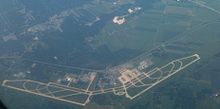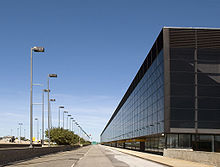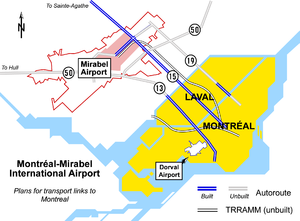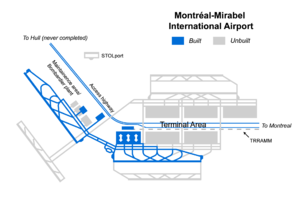- Montréal-Mirabel International Airport
-
"Mirabel" redirects here. For other uses, see Mirabel (disambiguation).
Montréal-Mirabel International Airport
Aéroport international Montréal-Mirabel

IATA: YMX – ICAO: CYMX Summary Airport type Public Owner Transport Canada[1] Operator Aéroports de Montréal Serves Montreal, Quebec Location Mirabel, Quebec Elevation AMSL 270 ft / 82 m Coordinates 45°40′50″N 074°02′19″W / 45.68056°N 74.03861°WCoordinates: 45°40′50″N 074°02′19″W / 45.68056°N 74.03861°W Website Map Location in Quebec Runways Direction Length Surface ft m 06/24 12,000 3,658 Concrete 11/29 8,852 2,698 Concrete Statistics (2010) Aircraft movements 34,857 Total cargo (metric tonnes) 93,000 Sources: Canada Flight Supplement[2]
Movements from Statistics Canada[3]
Cargo from ACI[4]Montréal-Mirabel International Airport, (or Montréal International (Mirabel) Airport) (IATA: YMX, ICAO: CYMX) originally called Montréal International Airport and widely known simply as Mirabel is an airport located in Mirabel, Quebec, Canada, 21 NM (39 km; 24 mi) northwest[2] of Montreal and was opened October 4, 1975. It was the largest airport in the world in terms of surface area ever envisioned, with a planned area of 39,660 hectares (396.6 km2). The King Fahd International Airport, which was completed in 1999, surpassed its surface area.
In 1989, 81,000 of the 98,000 acres (400 km2) were deeded back to their owners.[5] The predominant role of the airport is cargo flights but it is also home to MEDEVACs[6] and general aviation[2][7] flights as well as being a manufacturing base for Bombardier Aerospace, where final assembly of regional jet (CRJ700, CRJ900 and CRJ1000) aircraft is conducted. The former passenger terminal apron is now a racing course.
It was intended to replace the existing Dorval Airport as the eastern air gateway to Canada; from 1975 to 1997, all international flights to/from Montreal were required to use Mirabel. However, Mirabel's distant location and lack of transport links, as well as Montréal's economic decline relative to Toronto, made it unpopular with airlines and travellers, so Dorval was not closed as originally planned. Eventually, Mirabel was relegated to the role of a cargo airport. Initially a source of pride, the airport eventually became an embarrassment widely regarded in Canada as being a boondoggle and a white elephant.[8] Ironically, the Dorval Airport was renamed Montréal-Pierre Elliott Trudeau International Airport after the Canadian Prime Minister, Pierre Elliot Trudeau, the man who spearheaded the Mirabel project to replace Dorval.
The airport is classified as an airport of entry by NAV CANADA and is staffed by the Canada Border Services Agency. CBSA officers at this airport currently can handle general aviation aircraft only with no more than 15 passengers.[2]
It is one of two airports in Canada with sufficient right-of-way that can be expanded to accommodate 50 million passengers per year, the other being Toronto Pearson International Airport, though a lack of traffic meant that Mirabel was never expanded beyond its first phase. It is one of only two non-capital airports with fewer than 200,000 passengers a year to be part of the National Airports System.
The airport is 55 kilometres (34 mi) northwest of Downtown Montreal and 47 kilometres (29 mi) northwest of Trudeau Airport.[9]
Contents
Development
In the 1960s, Montreal experienced a tremendous economic boom. Massive construction projects, including the Montreal Metro coupled with the hosting of Expo 67 brought the city international status. More and more visitors were arriving to the city, especially by airplane, though not always by choice. The federal government required that European airlines make Montréal their only Canadian destination. This resulted in 15–20% annual growth in passenger traffic at the city's Dorval Airport. Optimistic about the city's future and its continuing ability to attract more and more visitors, government officials decided to build a new airport that would be more than able to absorb increased passenger traffic well into the 21st century.
The Canadian Department of Transport studied five possible sites for Montreal's new airport: Saint-Jean-sur-Richelieu (50 km to the southwest), Vaudreuil-Dorion (40 km to the west), Joliette (70 km to the north), St-Amable (30 km to the southeast), and St. Scholastique (60 km to the northwest).
The federal government proposed that the airport should be located at Vaudreuil-Dorion. This location was well connected by existing road and rail routes, as well as being close enough to serve the population of the city; furthermore it could serve as the gateway to Ottawa as well as Montréal. Quebec Premier Robert Bourassa, who had a frosty relationship with Prime Minister Pierre Trudeau, reportedly did not want such an important project to be placed so close to the Ontario border. The Bourassa government preferred that the new airport be situated in Drummondville (100 km to the east).
Expropriation
In March 1969, the federal and provincial governments reached a compromise to locate at the St. Scholastique site, and proposals were drawn up to expropriate 97,000 acres (390 km2), an area larger than the entire city of Montreal. It is served only by a long road link via Autoroute 15 and Autoroute 50. An additional link via Autoroute 13 was planned but never completed. Also planned was the connection of Autoroute 50 to the Ottawa/Gatineau area, a goal which will finally be achieved in 2012.
The federal government expropriation resulted in making Mirabel the world's largest airport by property area. (King Fahd International Airport in Saudi Arabia later surpassed Mirabel as the world's largest airport by property area, a record it still retains). The airport's operations zone, which encompassed what was eventually built plus expansion room, amounted to only 17,000 acres (69 km2), about 19% of the total area of the airport. The federal government planned to use the excess land as a noise buffer and as an industrial development zone (which was never started). This attracted the ire of the people of St. Scholastique who protested vehemently against the expropriation of their land. Nevertheless, construction started in June 1970 under the auspices of BANAIM, a government organization formed to build the airport.
High-speed rail transit (the system was to be capable of speeds from 100 to 120 kilometres per hour (62 to 75 mph) for the Montréal-Mirabel run), initially to be called TRRAMM (Transport Rapide Régional Aéroportuaire Montréal-Mirabel), was intended to be completed at a later date. However, it never got beyond the drawing board. The TRRAMM system was also intended to eventually be expanded to other parts of the Montreal region. The major stumbling block for the TRRAMM project was funding. The federal, provincial, and municipal governments never managed to find enough cash to fund the highly ambitious and expensive rapid transit project. Thus, Mirabel was forced to cope with an inadequate road system and non-existent rail transit, supplemented only by express buses run by Société de transport de Montréal (Montreal Transit Corporation).
Operational history and decline
Montréal-Mirabel International Airport opened for business on October 4, 1975, in time for the 1976 Summer Olympics. In the rush to get the airport open in time for the Olympics, it was decided to transfer flights to Mirabel in two stages. International flights would be transferred immediately, while domestic and US flights would continue to be served by Dorval airport until 1982.
The federal government predicted that Dorval would be completely saturated by 1985 as part of its justification for building Mirabel. They also projected that 20 million passengers would be passing through Montreal's airports annually, with 17 million through Mirabel. That claim never materialized, for by 1991 Mirabel and Dorval handled a total of 8 million passengers and 112,000 tons of cargo annually, while Toronto was handling 18.5 million passengers and 312,000 tons of cargo. Mirabel alone never managed to exceed 3 million passengers per year in its existence as a passenger airport.
After 1976, Mirabel and Dorval began to decline in importance due to the increasing use in the 1980s of longer-range jets that did not need to refuel in Montréal before crossing the Atlantic, and this trend commenced during Mirabel's planning stages. These factors dramatically reduced the amount of projected air traffic into Dorval. The result was that a second airport became unnecessary. Only Air Transat held out until the very end.
To ensure Mirabel's survival, all international flights for Montréal were banned from Dorval from 1975 to 1997. However, public pressure in support of Dorval prevented its planned closure, yet Dorval's continued existence made Mirabel comparatively expensive and unattractive to airlines and travelers alike. Dorval was only 20 minutes away from the city core while it took 50 minutes to get to Mirabel in ideal traffic conditions. Passengers who used Montreal in transit had to take long bus rides for connections from domestic to international flights, while Montrealers resented Mirabel as they were forced to travel far out of town for international flights. Many international airlines, faced with the stark economic reality of operating two Canadian points of entry, opted to overfly Montreal by landing instead in Toronto with its better domestic and US connections. The simultaneous operating of both Montréal airports resulted in Dorval being overtaken in traffic first by Toronto and then relegated to third by Vancouver International, as international airlines were slow to return to Dorval after it resumed handling international flights in 1997. Over time the decreasing passenger flights began to take a toll on businesses within Mirabel, particularly notable was the 354 room Chateau Aeroport-Mirabel hotel adjacent to the terminal, which was forced to shut down in 2002 after 25 years of operation.
Debate
In the late 1990s, Maclean's magazine interviewed one resident, whose farm was expropriated, who said that his land was sacrificed to save the city. He was particularly critical of the Trudeau government for not closing Dorval as well as failing to recognize Mirabel's potential, as no legislation similar to the Wright Amendment in the U.S. was enacted that would force airlines to use Mirabel instead of Dorval. Supporters of making Mirabel the sole international airport of Montreal pointed out that it had the capacity to be expanded significantly to meeting growing future demand, unlike Dorval. They also noted that Dorval could be closed and its land be developed for prime real estate, and some of the profits could go towards improving access routes to Mirabel and/or the airport itself.
The initial location of Mirabel was supposed to be a major justification for the project, not only because of its expansion room, but also the afforded buffer which would significantly reduce noise pollution in urban areas.
Present Day
The CAD$716 million expansion of Dorval from 2000–2005 gave it the ability to serve 20 million passengers a year, ironically accomplishing one of the goals that was to be met with the construction of Mirabel. (In the 1970s, the federal government projected that 20 million passengers would be passing through Montreal's airports annually by 1985, with 17 million through Mirabel). Aéroports de Montréal financed all of these improvements itself, with no government grants.[10]
Today, Montréal-Mirabel International Airport is used almost exclusively for cargo flights, with passenger operations having ceased on October 31, 2004, twenty-nine years after the airport's opening and many years of limited, primarily charter service. Bombardier Aerospace launches newly constructed units from its factory at Mirabel, and Bell Helicopter operates a commercial helicopter facility at Mirabel.[citation needed]
With very little or, later, no airline service, and with many empty spaces inside its terminal, Mirabel has been the setting of several movies, TV series, and commercials for many years. The movie The Terminal features the mezzanine overlooking the immigration desks and the baggage carousels directly behind them, the tarmac and the main terminal entrance (with a digitally added New York skyline reflection). All other terminal scenes were shot on a soundstage.[citation needed]
In 2006, I-Parks Creative Industries, a French firm that specializes in the creation of urban tourist attractions, and Oger International SA, the global engineering company owned by the family of slain former Lebanese prime minister and entrepreneur Rafik Hariri, entered into an agreement to turn Mirabel into a theme park. The proposed concept of the park is based on the theme of water and outer space.[11][12] By August 2008, negotiations, market research, and technical assessments were continuously delayed, and construction not started.[13]
In December 2006, in a move he called "correcting a historical injustice," Prime Minister Stephen Harper announced the return of 4,450 hectares of farmland expropriated to build Mirabel airport. About 125 farmers, who rent their land from the federal government, were permitted to buy it back. Harper said he was pleased to finish the work started by former prime minister, Brian Mulroney, who unlocked a major parcel of expropriated land during his first term in office in 1985.[citation needed]
In May 2007, it was reported that the International Center of Advanced Racing had signed a 25 year lease with Aéroports de Montréal to use part of the airport as a race track.[7][14] At the same time fixed base operator, Hélibellule, opened a facility at the site to cater for the private jets that were expected. The company also provides a passenger service from Mirabel to destinations in Canada and the United States.[15][16] They operate three different types of helicopters; Bell 222, Robinson R22 and Aérospatiale Gazelle.[15]
In August 2007, AirMédic moved from its base at Montréal/Saint-Hubert Airport to Mirabel. AirMédic is a non-profit humane foundation serving the population of Quebec and its visitors with the service of air ambulances. It offers MEDEVAC flights using a Eurocopter Dauphin.[6][17]
In August 2008, the Agence métropolitaine de transport said it was willing to expand its commuter rail service to the airport if passenger traffic were to return.[citation needed]
in July 2010, the ADM confirmed that I-Parks Creative Industries's long-delayed AeroDream project was dead, officially canceling it.[18] At present there are no plans for any alternative development at the site.
Architecture and layout
Mirabel was designed to be eventually expanded to six runways and six terminal buildings, with a separate STOLport also planned. The expansion was supposed to occur in a number of phases and be completed by 2025. However, the airport never got beyond the first phase of construction, and by October 2005 runway 11/29 was closed leaving only runway 06/24 operational.[citation needed]
From the furthest reach of the parking lot to the airplane seat, one can walk as little as 200 metres. A train station was also built in the basement for the planned TRRAMM service, right below the main passenger concourse. Today, it is used as an employee parking lot.[citation needed]
Designed by architects Papineau-Gérin-Lajoie, Mirabel's terminal carried over their creator's award-winning Expo 67 Quebec pavilion design. A simple minimalist dark glass box sitting on top of a concrete bunker housing maintenance services, the terminal was hailed as an architectural triumph when it first opened. The only terminal was designed to handle six million passengers per year.[citation needed]
Passengers walked as little as 100 metres going from the curb to the gate. Once there, passengers would be transported to their aircraft by Passenger Transfer Vehicles (PTVs), rather than walking through jetways. The PTVs, similar to those at Washington Dulles International Airport, ran from the terminal to the aircraft parking spot on the ramp. It was reported by Radio-Canada/Canadian Broadcasting Corporation that each of these vehicles had cost up to C$ 400,000 at the time.[19] To eventually make connections between flights easier, the terminal also included a few jetways, in a smaller concourse called the Aeroquay, accessible via an underground tunnel and later connected directly to the main concourse.
Airlines and destinations
 Air India Boeing 747-200B at Montréal-Mirabel International Airport in 1983.
Air India Boeing 747-200B at Montréal-Mirabel International Airport in 1983.
Mirabel initially opened with service from local airlines Air Canada, Canadian Pacific Airlines and Nordair (Quebecair), as well as airlines from more than fifteen countries, including Aer Lingus, Aeroflot, Air France, Alitalia, British Airways, Czech Airlines, El Al, Iberia Airlines, KLM, Lufthansa, Olympic Airlines, Sabena, Scandinavian Airlines System, Swissair and TAP Portugal. These airlines had their national country flags posted in front of the terminal on the inauguration of Mirabel.
Other airlines to have flown to Mirabel at some point were Aerolíneas Argentinas, Aeroméxico, Air India, Air Liberté, Business Express Airlines (operating as Northwest Airlink), Corsairfly, Cubana de Aviación, Finnair, Jaro International, Jat Airways, LAN Chile, LOT Polish Airlines, Peoplexpress Airlines, Royal Air Maroc, Royal Jordanian, TAROM, and Varig. Most gradually lost faith in Mirabel and either transferred to Dorval in 1997 or pulled out of Montreal altogether.
Several charter airlines also served Mirabel, such as Wardair, Nolisair, Canada 3000 and Royal Aviation. All four have either merged or gone out of business. Air Transat is the only charter airline that started operations at Mirabel and stayed until the end of passenger service in 2004.
Today, the only major users of Montréal-Mirabel International Airport are cargo airlines.
Airlines Destinations Cargojet Airways Hamilton, Winnipeg DHL Express Cincinnati FedEx Express Indianapolis, Memphis, Newark, Ottawa FedEx Feeder operated by Morningstar Air Express Moncton, Quebec City, Toronto-Pearson Kelowna Flightcraft Air Charter Moncton, Ottawa, Winnipeg Nolinor Aviation SkyLink Aviation Quebec City UPS Airlines Louisville Other facilities
Bombardier Aerospace houses its Defence Services Division on the property of Mirabel Airport.[20]
Incidents and accidents
The following accidents occurred either at the airport, or involved aircraft using the airport:
- June 23, 1985: Air India Flight 182, a Boeing 747-200B enroute from Montréal-Mirabel to London Heathrow Airport was blown up by a terrorist bomb off the coast of Ireland, killing all 307 passengers and 22 crew.
- January 21, 1995: Royal Air Maroc Flight 205, a Boeing 747-400 preparing to depart for New York City and Casablanca, was being de-iced by Canadian Airlines groundcrew, while its engines were running. Due to a communications error, the pilot believed de-icing was complete and started taxiing forward. Two deicing vehicles that were still in place in front of both horizontal stabilizers were knocked down, causing fatal injuries for three de-icing crew members and serious injuries to the two drivers.[21]
- June 18, 1998: Propair Flight 420, a Fairchild Swearingen Metroliner flying from Dorval International Airport (now Montréal-Trudeau International Airport) to Peterborough Airport in Peterborough, Ontario, experienced a wing/engine fire during the initial climb. It attempted an emergency landing at Mirabel, but crashed near the beginning of the runway, in part due to a landing gear failure. The two pilots and the nine passengers on board were killed.[22]
See also
Notes
- ^ "Airport Divestiture Status Report". Tc.gc.ca. 2011-01-12. http://www.tc.gc.ca/programs/Airports/Status/menu.htm. Retrieved 2011-02-23.
- ^ a b c d Canada Flight Supplement. Effective 0901Z 20 October 2011 to 0901Z 15 December 2011
- ^ Total aircraft movements by class of operation — NAV CANADA flight service stations
- ^ 2010 North American final rankings
- ^ History section of the Aéroports de Montréal site
- ^ a b Gazette, The (2007-08-30). "It's liftoff for AirMédic ambulance". Canada.com. http://www.canada.com/montrealgazette/news/story.html?id=d84a7648-6515-4b48-ae49-357a337229da. Retrieved 2011-02-23.
- ^ a b La Presse (2007-05-14). "Mirabel redécolle". Lapresseaffaires.cyberpresse.ca. http://lapresseaffaires.cyberpresse.ca/article/20070514/LAINFORMER/705140647. Retrieved 2011-02-23.
- ^ End of Era Near in Montreal For White-Elephant Airport, CLIFFORD KRAUSS, New York Times, October 3, 2004
- ^ "Montréal-Mirabel map." Aéroports de Montréal. Retrieved on December 4, 2010. French version.
- ^ Aéroports de Montréal Provides a Progress Report on Work at Montréal–Trudeau[dead link]
- ^ Airport to be turned into amusement park (21 February 2006). CTV News. Accessed March 25, 2006.
- ^ Delean, Paul (22 February 2006). Mirabel may take off as theme park. The Montreal Gazette.
- ^ Mirabel AeroDream Aéroports de Montréal. Accessed February 22, 2008.
- ^ "ICAR – a new motorsport facility in Quebec". Racing.auto123.com. http://racing.auto123.com/en/racing/news/index,view.spy?artid=91100. Retrieved 2011-02-23.
- ^ a b "Hélibellule fleet". Helibellule.ca. http://www.helibellule.ca/en/flotte.php?laSection=3&intro=1. Retrieved 2011-02-23.
- ^ Hélibellule fait revivre le transport des passagers à Mirabel[dead link]
- ^ "AirMédic". Airmedic.net. http://www.airmedic.net/. Retrieved 2011-02-23.
- ^ [1][dead link]
- ^ Mirabel looks for new role–again (28 April 2004). CBC News. Accessed September 22, 2005.
- ^ "Aerospace Directory." Bombardier Inc. Retrieved on December 4, 2010. "10000 Helen-Bristol Street Montréal Airport, Mirabel Mirabel, Québec." Address in French: "10000, rue Helen-Bristol Aéroport de Montréal, Mirabel Mirabel (Québec) J7N 1H3 Canada."
- ^ "Collision with Vehicle Royal Air Maroc". Tsb.gc.ca. 2008-07-31. http://www.tsb.gc.ca/eng/rapports-reports/aviation/1995/a95q0015/a95q0015.asp. Retrieved 2011-02-23.
- ^ "Swearingen SA.226TC Metro II". Aviation-safety.net. 1998-06-18. http://aviation-safety.net/database/record.php?id=19980618-0&lang=en. Retrieved 2011-02-23.
References
- Financial Times of Canada. (1975). Mirabel. Special ed. Don Mills, ON: Financial Times of Canada.
- Aeroports de Montréal ADM History
- Durivage, Simon."Mirabel, airport of the year 2000." Montreal, Montreal. 8 Sep 1992. Video Archive.
- Radio-Canada, "De Mirabel à Dorval", 14 May 1999, Web archive (French)
External links
Listen to this article (info/dl)
This audio file was created from a revision of Montréal-Mirabel International Airport dated 2006-10-03, and does not reflect subsequent edits to the article. (Audio help)More spoken articles- Aéroports de Montréal
- Page about Mirabel Airport in the Canadian Owners & Pilots Association Places to Fly Airport Directory
- The airport whose demise was caused by rail absence a critique of the Mirabel Airport closure
- Past three hours METARs, SPECI and current TAFs for Montréal-Mirabel International Airport from NAV CANADA as available.
- New York Times feature
Airports in Canada By name A–B · C–D · E–G · H–K · L–M · N–Q · R–S · T–ZBy location indicator CA · CB · CC · CD · CE · CF · CG · CH · CI · CJ · CK · CL · CM · CN · CO · CP · CR · CS · CT · CV · CW · CY · CZBy province/territory National Airports System Calgary · Charlottetown · Edmonton · Fredericton · Gander · Halifax · Iqaluit · Kelowna · London · Moncton · Montréal-Mirabel · Montréal-Trudeau · Ottawa · Prince George · Québec · Regina · Saint John · St. John's · Saskatoon · Thunder Bay · Toronto · Vancouver · Victoria · Whitehorse · Winnipeg · YellowknifeRelated List of airports by ICAO code: C · List of defunct airports in Canada · List of heliports in Canada · List of international airports in Canada · National Airports System · Operation Yellow Ribbon Category ·
Category ·  Portal ·
Portal ·  WikiProjectCategories:
WikiProjectCategories:- Airports in Quebec
- Airports established in 1975
- Transportation in Montreal
- Transportation in Laurentides
Wikimedia Foundation. 2010.





